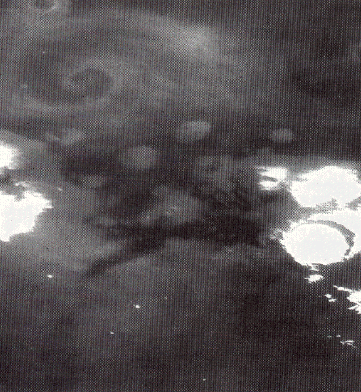This is an image of a Martian storm front.
Image from: NASA
Martian Storm
This is an image of a storm moving across the Martian terrain. The camera is looking down upon the storm and the storm front forms a spiral pattern, the same way terrestrial storms are presented on the evening news. The storm provides evidence of water, and a water cycle on Mars.
As early as 1796 scientists were reporting "yellow", and "white" or "bluish" clouds in the Martian atmosphere. However, it wasn't until the Mariner 9 mission that clouds of water were positively identified.
Clouds seem to be plentiful only in the middle latitudes, and many of the cloud formations seem to be due to topographic forcing by Olympus Mons. More study is needed to understand just how the clouds come and go in the Martian atmosphere. For example, even though clouds have been found, there is still little evidence when and where it actually rains on Mars, if at all.
You might also be interested in:

Prior to the Mariner missions, we had to rely on ground-based observations to look at Mars. Using ground-based observations, scientists were able to identify channels, polar caps which varied with season,
...more
This is the first image showing clouds of Mars taken from the lander. Ground based viewing of Mars has shown that clouds seem to be plentiful only in the middle latitudes This may be because water of Mars
...more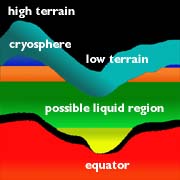
The Martian geography is one of high altitudes at high southern latitudes and low altitudes at low latitudes. The ground is less frozen at low latitudes because it is warmer and water can evaporate. Thus,
...more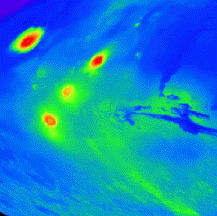
On this map of Mars, the lightly cratered Tharsis Ridge is shown, as well as the heavily cratered Martian highlands (near the bottom of the picture), and Valles Marineris to the right. The volcanoes are
...more
The unusual global geography of Mars helps to explain the fact that water has been drawn from the southern hemisphere to the northern hemisphere of the planet through all of Martian history (that is, from
...more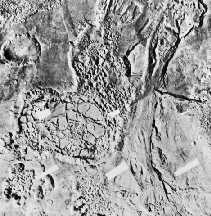
Separate from the Martian outflow channels, or the river valley networks, are large Martian lakes (600 km, or ~1000 miles across) which exhibit evidence of a periodic and catastrophic release of water
...more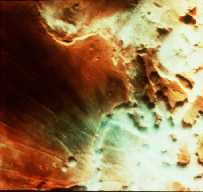
This is an image of fog in a Martian canyon. The presence of fog provides evidence of water, and a water cycle on Mars. More fog has been seen in images returned by Mars Global Surveyor of the south polar
...more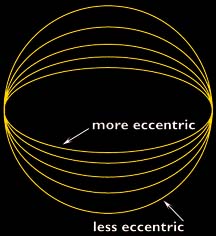
The Martian climate is more influenced by the shape of the Martian orbit than the climate of the Earth is influenced by the shape of the Earth's orbit. The orbit of Mars is more elliptical than that of
...more
